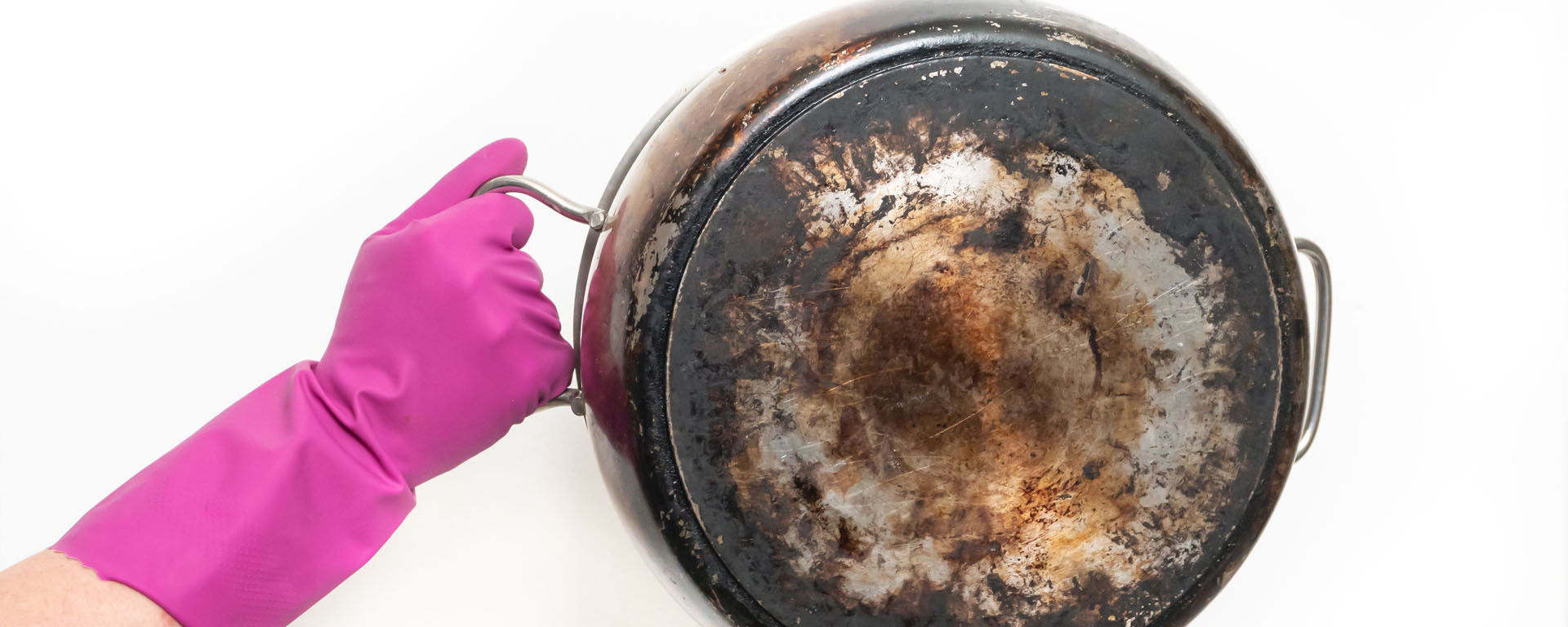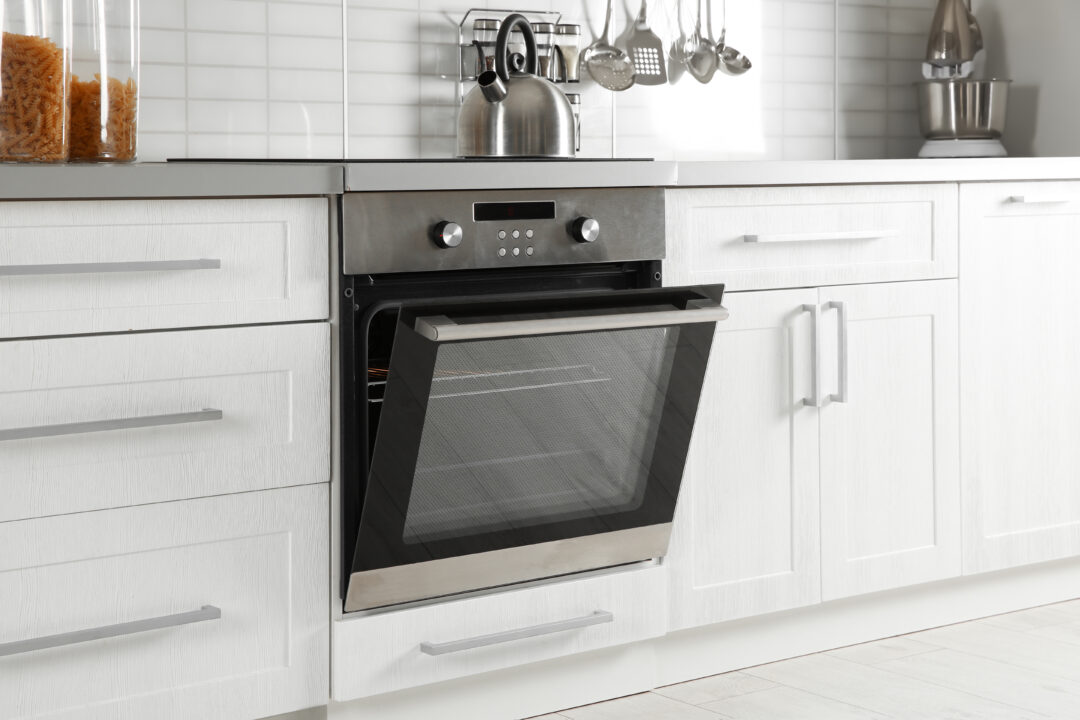Cleaning a burnt pot can seem daunting, but it does not mean your burnt pot has to be tossed away. These are a few simple methods to get your burnt pots looking as good as new.
Some ways to clean a burnt, blackened pot are with baking soda, vinegar and boiling water. You will need a scouring sponge and something to scrape the burnt pot with like a wooden spatula. If you are fed up with buying new pots each time one of your pots is burnt, these cleaning tips are for you.
1. How To Clean A Burnt Pot With Baking Soda
Baking soda is a go-to natural, home-remedy for all sorts of cleaning which makes baking soda the first solution to clean a burnt pot. Baking soda is a mild alkaline cleaning agent, strong enough against the toughest dirt and grime, and easy to rinse off. Also, as it is a natural chemical compound, it’s safe to use around your family, pets and kitchenware. It’s a great cleaning agent to use when learning how to clean a burnt potjie pot.
For this method you will need baking soda, water, and a scouring pad.
Follow these six steps to clean your burnt pot with baking soda:
- Start by scraping away as much of the burnt debris as you can, use a wooden spatula for this.
- Sprinkle a few cups of baking soda into the burnt pot, enough to cover the whole burnt area of the pot.
- Fill a quarter of the pot with hot water and leave the pot to sit for about 15 minutes.
- Sit the pot with the baking soda and water in the sink, you will notice a fizzing, bubbling reaction. You can simply leave the reaction to die down.
- Proceed by pouring out the liquid contents of the pot, then scrub the rest of the pot’s burnt bits with a sponge or scouring pad.
Tip: Add more baking soda gradually when scrubbing your burnt pot wherever necessary.
- Rinse and dry, there should be no remaining residue or dirt.
Alternatively, you can make the baking soda into a paste by adding small amounts of water – apply the paste to your burnt pot generously, and follow the same process.
2. How To Clean A Burnt Pot With Vinegar And Baking Soda
For this method, you will need to utilise vinegar, another natural cleaning agent. White or cleaning vinegar along with baking soda is able to dissolve dirt, grease and bacteria, making it ideal for cleaning heavy duty or stainless steel burnt pots. Distilled white vinegar is slightly more powerful, and acidic, but either will be effective in cleaning a burnt pot.
For a more intensive cleaning of your burnt pot with white vinegar and baking soda, follow these six steps:
- Repeat the first step of the previous method, begin by removing most of the crusty, burnt debris from your pot first.
- Pour white vinegar into the pot, enough to cover the whole burnt area. It’s up to you whether you want to add some water to dilute the vinegar, it’s not a must.
- Place your pot filled with white vinegar on a stovetop, bring it to a boil and leave to simmer for some minutes.
- Take the pot off the heat, leave the contents to cool for a moment. Then add a cup of baking soda to the liquid (a fizzing chemical reaction will be activated from the mixture of vinegar and baking soda), let the reaction die down.
- Pour out the mix of white vinegar and baking soda from your pot, continue to scrub the pot with a scouring pad while adding bits of baking soda if nessecary. Scrub until there are no burnt remnants left.
- Rinse and dry. Your pot should be as good as new.
3. How To Clean A Burnt Pot Using Dishwasher Detergent Or Tablet
A dishwasher tablet or detergent is a simple, effective cleaning hack to restore a pot after burning it to the point of no return. It is common to just place a blackened pot into the dishwasher, but it may not pristinely clean those burnt bits.
Take a look at these five quick steps to learn how to use a dishwasher tablet or detergent to clean your burnt pot:
- Add one dishwasher tablet or one tablespoon of powerdered dishwasher detergent to your burnt pot.
- Fill your pot with a couple of inches of boiling water from the tap, leave the pot to soak for roughly 30 minutes.
- Using a wooden spatula proceed to scrape the bottom of the pot, checking that the charred debris lifts from the pot’s surface with ease. If it is coming off easily, then pour the remaining liquid out from the pot and continue scrubbing clean.
- If stubborn residue is left over, kick it up by bringing the detergent and water mixture to the boil, leaving it to simmer for 10 minutes.
- Remove the pot from the heat, let it soak while cooling down. Once cooled, pour out the remaining contents, and scrub the rest of the burnt area of the pot. Repeat this as many times as necessary, then wash thoroughly until your pot is completely clean.
Tip: Make sure to use powdered detergent or a dishwasher tablet, the liquid detergent will not have the same desired effect.
4. How To Clean A Burnt Pot Using Lemons
Lemon and water is another popular solution for a tough to clean, burnt pot. The citric acid found in lemons has certain properties that make it a stain remover for your burnt pot, while leaving a citrus, refreshing scent in your kitchen. This method is one of the fastest and easiest solutions for cleaning a burnt pot, depending on how burnt your pot is.
How to use lemons to clean your burnt pot in four simple steps:
- Cut two to three lemons into quarters, place them into your pot. Add a cup of water, make sure it covers a few inches of the pot and begin to heat.
- Bring the water and lemon slice mixture to a boil for 5 – 10 minutes, or until burnt particles start to lift off and float to the top.
- Pour the mixture out of your pot, rinse off excess residue, and with a scouring pad or sponge proceed by scrubbing left over charred bits.
- Rinse, dry, enjoy your pot – now free of burnt debris.
Ways To Prevent Burning Pots in Future
You managed to clean your burnt pot, finally. The pot looks better than you remember, relieved from leftover burnt food that was once impossible to clean. To avoid overheating and burning your pots, there are some precautions you can take during your cooking time.
To prevent burnt pots in the kitchen, read the four helpful tips below:
- Keep your stovetop clean
Often when we cook, we overlook accidental splashes of sauce or spilled greasy food items across the cooktop. These bits of residue accumulate and burn once exposed to direct heat or flame of the burner. This usually ends in burning the whole bottom surface of your pot. You can avoid this by knowing how to clean a glass stovetop. Simply wipe and scratch off any burnt bits of food from the stovetop everyday before you start cooking, this will prevent burning of your pots.
- Grease your pot or pan before cooking
Before you start cooking, greasing your pot with oil is essential before adding the food. Oil provides moisture to the pores in the pot or pan material, once heated it creates a non-stick layer. Always remember to grease your pot with oil, let it coat the bottom of your pot. Heat the greased pot or pan over a medium heat or flame. Pre-heating the oil in the pot before cooking prevents food residue from sticking to the pot and leaving dark marks.
- Use the correct burner
Avoid placing your pot onto a burner that’s circumference is smaller than your pot or pan, uneven thermal transfer means unbalanced cooking, and a burnt surface on your pot.
- Stir frequently
When cooking make sure to stir the contents of your pot in regular intervals. Use a wooden spoon to allow the contents inside the pot to cook evenly over the heat. If you use non-stick pots and pans, it is strongly recommended to give them a quick check from time to time once placed on a flame or heated burner.
Now that you know the best techniques to clean burnt pots, and ways to prevent it happening in the future, they will become a thing of the past. Get your storage containers to match your pots by knowing the best ways to clean plastic food containers. Cook without worry and share your new-found knowledge with your friends. If you want to give your kitchen a thorough clean but aren’t sure where to start, you may want to take a look at how to clean a kitchen for step by step tips and guidelines.







